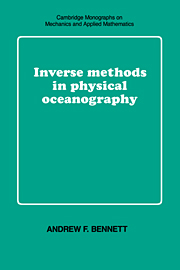Book contents
- Frontmatter
- Contents
- Preface
- 1 Finite-dimensional inverse theory
- 2 The smoothing of observations
- 3 Data assimilation
- 4 The spatial structure of the Kalman filter
- 5 Generalized inverses of dynamical models
- 6 Antenna analysis
- 7 Nonlinear quasi-geostrophic models
- 8 Open-ocean modelling: quasi-geostrophy
- 9 Primitive-equation models
- 10 Outstanding problems
- Bibliography
- Subject index
8 - Open-ocean modelling: quasi-geostrophy
Published online by Cambridge University Press: 08 January 2010
- Frontmatter
- Contents
- Preface
- 1 Finite-dimensional inverse theory
- 2 The smoothing of observations
- 3 Data assimilation
- 4 The spatial structure of the Kalman filter
- 5 Generalized inverses of dynamical models
- 6 Antenna analysis
- 7 Nonlinear quasi-geostrophic models
- 8 Open-ocean modelling: quasi-geostrophy
- 9 Primitive-equation models
- 10 Outstanding problems
- Bibliography
- Subject index
Summary
Introduction
The conventional introduction to partial differential equations uses examples from classical physics: potentials, diffusion and waves. The partial differential equations (pde's) only describe the local shape of solution surfaces in space or space-time; a unique, global determination of the solution requires that some of its values be provided at least on certain faces of the domain in space or space-time. That is, initial and boundary conditions are needed. The choice of initial conditions is usually simple, with causality being the guide. The thermodynamic or mechanical state of the system must be completely specified at an instant. Boundary conditions, on the other hand, make manifest the nature of the rest of the universe. In particular the familiar conditions of Dirichlet, Neumann and Robin (Jackson, 1962) indicate both the type of surrounding medium and the time interval of interest. For example, the Dirichlet condition for the diffusion equation reveals the presence of a reservoir of so great a capacity that its level does not change as the reservoir is emptied or filled by diffusive exchange with the system of interest. On the other hand, the homogeneous Neumann condition indicates that the surrounding medium is so effectively insulating that no significant diffusion takes place during the time interval of interest. The Robin or mixed condition is no such idealization of a simple property. By specifying a diffusive flux proportional to the state of the system, the condition models a more complex transfer process, involving both the system and the rest of the universe.
- Type
- Chapter
- Information
- Inverse Methods in Physical Oceanography , pp. 203 - 256Publisher: Cambridge University PressPrint publication year: 1992



